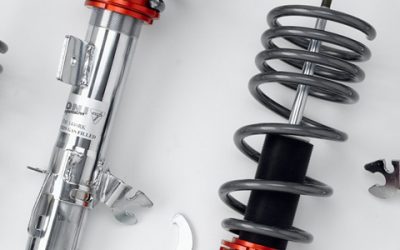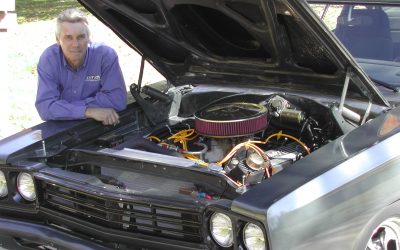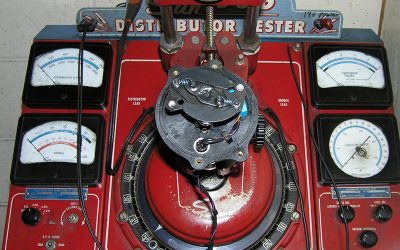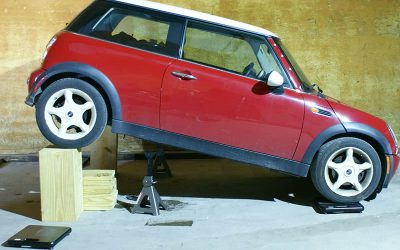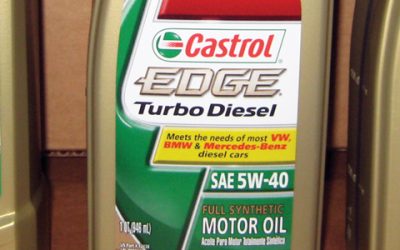Flat Tappet Oils & Additives
In spite of the wholesale O.E. switch to roller lifters that started a couple of decades ago, if you’ve got a vintage rod chances are it has flat tappets, and maybe you don’t want to go to the trouble and expense to retrofit to rollers. Plus, some racing venues only allow flat tappets. These operate at higher temperature and pressure levels at the lobe/lifter interface than rollers do, so require greater wear protection. The primary anti-wear additive for flat tappet camshafts and lifters is ZDDP (zinc dialkyl dithiophosphate), but that’s been phased out of ordinary motor oils mostly because of fears that it’ll foul the cat. Racing oil and additives provide zinc in adequate quantity to provide the protection you need to prevent catastrophic lobe and lifter wear.
Handling the Change, or Changing the Handling, Part 3: Suspension Upgrade
In the past two installments we discussed how the dimensions of a car and its overall weight distribution can affect cornering and handling. Let’s see how we can utilize this information and begin to upgrade the suspension.
Protecting Your Eyes and Hearing
Protecting your eyes and hearing is your responsibility. It’s easy to do, but many technicians do not make the effort to protect themselves. Change that habit!
Nissan TechNews Fall 2014
How to deal with EVAP problemts, review of valve clearance adjustments, key-off drain diagnosis, and the regenerative braking system
Valve Adjustment: A Touchy Feely Subject (A Review of Valve Clearance Adjustment on Nissan Vehicles)
Here’s a review of the once-common skill of valve clearance adjustment and how it should be done on modern Nissan vehicles.
Oh My, I Think I've Got the Vapors!
How to deal with EVAP problems without developing indigestion.
CC Rider, Part 2: Step-by-Step
Last time, Greg explained static and dynamic compression, the factors that determine them, and how to calculate what you’re going to get. Now, he gives us the proper procedures for measurement.
CC Rider, Part 1
What we’re talking about here is a bunch of “C” words — cubic centimeters, combustion chambers, compression, and calculation.
Starting Line: (What’s) Under The Hood
You may have noticed that HOT ROD Professional has morphed into Performance Technician. What does that mean? Initially, it means a renewed commitment to a wider variety of performance-related topics of interest to you, our tech-savvy readers.
Performance Technician August 2014
You may have noticed that HOT ROD Professional has morphed into Performance Technician. It means a renewed commitment to a wider variety of performance-related topics of interest to you, our tech-savvy readers.
Whistling Syclone
GMC came out with the Syclone pickup and we got just one in on allocation. A local street racer decided to relive his mis-spent youth and stopped in to buy the only one we had (fewer than 3,000 were built in 1991, and only about dozen in 1992.)
Basics Series: Connecting Rods
Our esteemed tech editor shows us that there’s a lot more to connecting rods than most of us have ever imagined.
Volkswagen TechConnect Summer 2014
In this issueCAN We Do This? Supply and Demand - Fuel Motor Oil: VW Fluids We Have Ignition! Or, Do We?
Performance Tool Box for Carbureted Engines – Tools of the Trade
Is tuning an engine for maximum performance and/or fuel efficiency an art or a science? We’ll cover the basic and specialty tools every tuner should have in his/her tool box.
We Have Ignition! Or, Do We?
The job of the ignition system is to provide the spark that initiates combustion, and it’s our job to keep this process going. To do that effectively, we need a firm grasp of how the system works.
Changing the Handling, or Handling the Change? Part 2
In Part 1, we covered the benefits of track width, lowering your center of gravity, and adjusting your corner weights. This time, we’ll show you how.
Motor Oil: VW Fluids Raise the Performance Bar, Part 1
The trend in automotive fluids is to be application-specific. Here we highlight critical information about motor oil to help you make your choice for a given Volkswagen application.
Supply & Demand – Volkswagen Fuel Supply
When customers experience drivability problems, it is our job to isolate the cause. With systems changing all the time, we must keep pace. Even something as simple as fuel supply has had updates and changes that we need to be aware of. The first successful...
CAN We Do This?
The CAN concept has made our lives easier by connecting all the computers in the car in a network we can access with a scan tool. But what do we do when you cannot communicate with one or several of those computers?
Tuning a Carburetor-Equipped Supercharged Engine
Whenever people see a carburetor-equipped supercharged engine in a hot vehicle, they can’t help noticing how impressive it looks, and they wonder how much power it produces. But they also see an engine they think is almost impossible to tune, is not very reliable, and will overheat at the drop of a hat. It doesn’t have to be that way.
High-Performance Brake Upgrades, Part 3: Friction Material
So far we’ve looked at the components that supply the pinching force and the ones that spin off all that heat. Here we’ll talk about the interesting subject of lining “recipes” and what you should choose for your hot car or truck.


